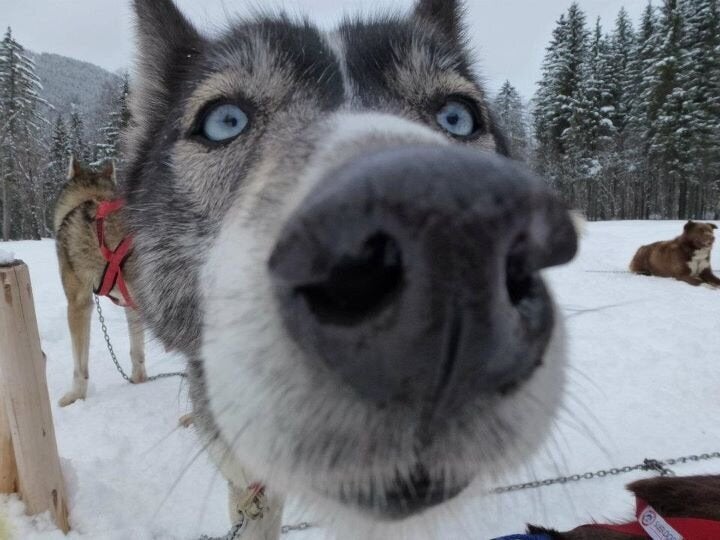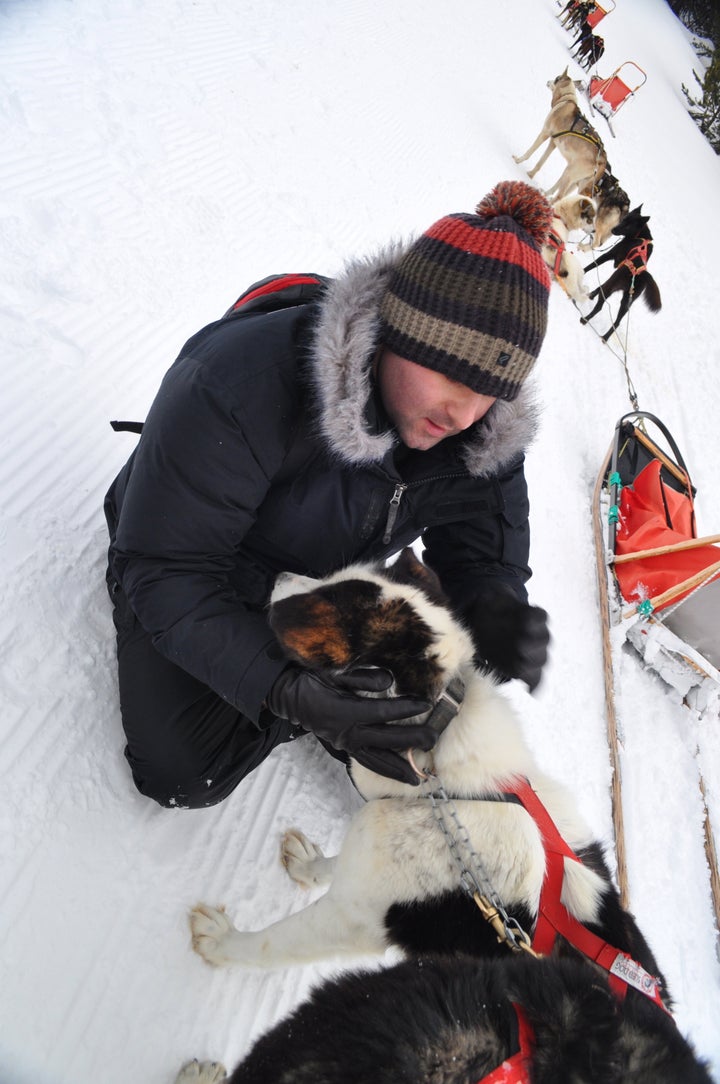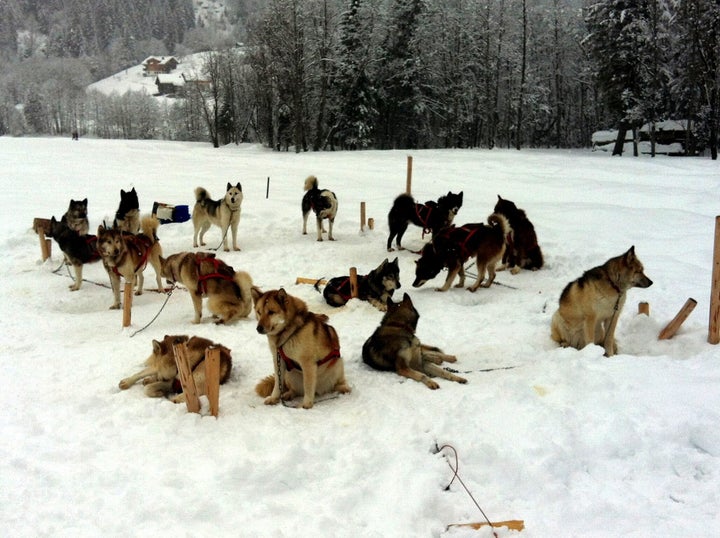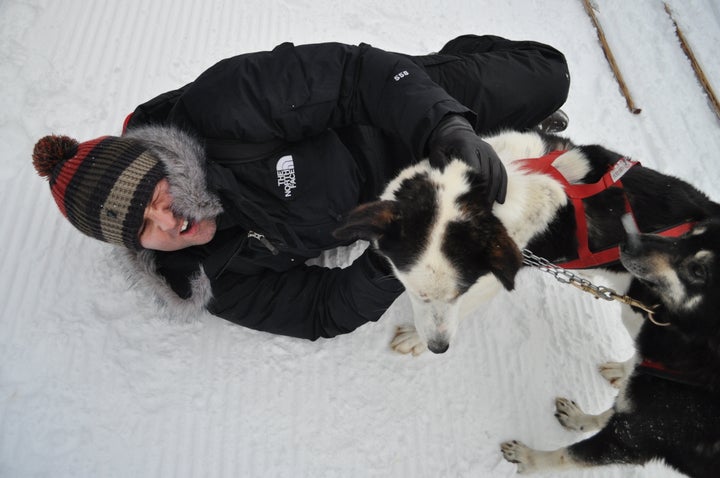Huskies are cute. They have something exotic and rare. An Arctic charm. They are dogs with a purpose; everyday dogs, work dogs and you never see one stuffed into Paris Hilton's handbag. In fact, from the entire canine family, they are perhaps the most striking. From their thick overcoat of cold-resilient fur to their Paul Newman glacier-blue eyes, they are fit, elegant and charming.
What the photographs don't tell you however, what every image you ever see of their adorable face with their explorative eyes and pokey-wet nose doesn't show, is just how much they smell. Not a pong in the air, like most dogs give off, that 'wet dog' scent that clings to clothes, sofas, cushions and every fabric in the house, but an air-carrying stench that grips your vitals.
Huskies leave behind two things in their snowy-wake: powder trails and a malodorous stink, as if walking into Shrek's bathroom once he's deposited Christmas dinner.
Sure, huskies hold their adorability in photographs, but in reality, their reeking aroma could peel wallpaper. A kind of builder's BO. But I expect nothing else from these powerful, working dogs.

The history of huskies and their usage is long and ever-changing. The practice of using dogs to pull sleds dates back to at least 2000 B.C. and is thought to have originated in Siberia or North America. By the time of the first World War, the use of dogs had spread to European countries such as Norway, where dog-sleds were used as ambulances in the woodlands and mountains to bring supplies to soldiers in the field. Then and now, the dog's working ability over-rides their need to be kept as household pets, and therefore cross-breeding is important in order to combine characteristics and to enhance abilities.
The word "husky" comes from "Huskimos", a pronunciation given to the Arctic Eskimos by English sailors. The use of the word dates back to 1852, when describing the dogs kept by Eskimo people to pull sleds and guard villages. Originally landrace dogs, they are thought to be one of the world's oldest breeds.
The Siberian husky and Greenland dog are modern, pure breeds, used for sled pulling, while the Sakhalin husky - a Japanese sled-dog - is related to the Japanese Spitz and Akita Inu. The Siberian dog of the north is the closest breed to a wolf relative, which is perhaps why they have a reputation of being difficult to tame, keeping intact its wild animal instincts. The Alaskan husky is a specific breed found only in Alaska (though many are being brought to new countries specifically in order to work and race), and therefore differs from the Siberian and other Arctic breeds. The Mackenzie River husky is a subtype and refers to a population in the Arctic and sub-Arctic regions of Alaska and Canada. They are long-coated and long-legged, built for heavy freighting in single file through deep snow.
Today, there are two main types of sled-dog races: sprint and long-distance. It's very much the canine Olympics, except all the best racers come from the freezing regions and not Jamaica. To my knowledge there is no standout performer. No dog is recognised the world-over for its athleticism and domination. All dogs are fair and equal. No dog has ever done the Mobot or Lightning Bolt.


Like a bobsleigh run, the structure of the team is vital. The "Musher" is the guide and command caller. They are the human element at the rear of the setup. Then is the sled: a wooden, Kevlar or more likely nowadays, titanium plank, that separates man from beast. In front of the sled are the "Wheel dogs", the strongest dogs on the team, followed by "Team dogs" who provide the power and then "Swing dogs", who follow the lead and are responsible for turning the sled around corners. At the front are the "Lead dogs" who follow the trail and set the pace. They respond to the Musher's voice commands and are the first to turn and accelerate.
In Leuenen I agree to race these puppies of athleticism, with no training whatsoever. It's just about holding on, right? To be one with the dog. To let it know who's in charge, remind them that they're my best friend - or so the saying goes.
As I approach the course, the dogs are collared individually, pegged into a circle. Some are creamy and noticeable by their black noses, others have coal-black coats and role about in the snow. Curious eyes clock me and those who are laying down rise to join the others. They bark loudly and tussle each other for vocal victory. There is a deep "huuuh huuuh huuuh" as they pant heavily, and that workman-dog smell begins to weave through my nostrils.

Despite the rancid stench, I remain transfixed. One cannot resist their eyes. They are captivating, the heterogamous of the eye results in a glassy blue, green or yellow marble, like dripping paint into a glass of water. Theirs are the most beautiful example of animal eyes, clear and curious.
Huskies want to be worked. They want to be raced. To open-up, stretch-out and flex their sprinting muscles. From a pack of twenty, all wish to be selected and put to work. It's like picking teams in the school playground. Two particularly large specimens are the quietest. They are Alaskan Malamute, the most powerful of sled-dogs, brought her to work with the team. They sit side-by-side, confident in their ability to perform and sure of automatic selection. The rest are the arm-wavers of the class, the "Pick me! Pick me!" students. Some will gain selection, others will not, left to watch and roll in the snow.
Two Siberian huskies position themselves as wheel dogs. They are harnessed and roped together into a compact dual. They are the closest to me and I witness their agile strength, and pencil sharpeners. The legs are powerful and well equipped for harsh turns and endurance. Their shoulders are wide, from neck to rump, about 55cm and they can sense any weak spots in the ice.

To watch a dog run is a phenomenal thing. To watch a pack run effortlessly across the glistening surface of fresh virgin snow, is unique. Each leg is like a muscled-hinge, able to bend and extend at high-tempo, barely touching the space below. They are wild and confident, moving with a sure-footed lightness. Their pink, elastic tongues hang out and breathe in the pinch of Alpine air.
I race the short course, about 800m. My confidence tells me that I'll hang on for the entirety, but I fall at 20m. While all my concentration is focused on the upper-half of my body and holding on, I neglect my legs.
Thud! I hit the deck.
I pick myself up. The sudden decrease in cargo weight is felt by the pack and they holt surprisingly quickly, respectable of my mistake. They all wait patiently. I need them to. The two wooden brackets on which I stand are slippery from the on-off application of snow and has frozen. A centimetre of frozen ice separates my feet from the brackets and my boots lack grip. I hold on tighter and begin to jog forward, then call "... anndddd Go!" and that's it, the dogs bolt forward, happy to be in stride again; awake, alive, active, dynamic in their excitement and unceasing in their work ethic.
They are dazzling across the snow and I am entirely in their command.